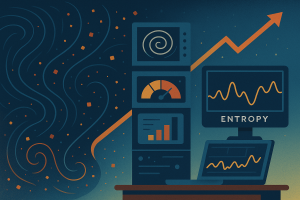The Weather Report for Digital Chaos: How Entropy Management Systems Track True Randomness
There’s something delightfully absurd about needing a dashboard to monitor chaos. Yet here we are, in 2025, watching live feeds of quantum computers rolling invisible dice with lasers and light, tracking their randomness output like meteorologists tracking storm systems. Entropy Management Systems (EMS) have become the weather stations for digital unpredictability, and frankly, it’s about time.
Think about it: we live in a world where your online banking, your gaming sessions, your private messages, and even your cryptocurrency transactions all depend on truly random numbers. Not the fake random that classical computers pretend to generate (those predictable imposters), but genuine, certifiable, physics-approved randomness. The kind that makes mathematicians giddy and hackers weep.
But here’s the kicker. Not all randomness is created equal. Some sources are quantum-grade, others are atmospheric noise, and some are just classical computers having really elaborate tantrums. EMS platforms let you see exactly what flavor of chaos you’re dealing with and craft custom solutions that require the absolute best entropy available. It’s like having a sommelier for randomness, helping you pair the perfect unpredictability with your specific security needs.
Use Case One: The Quantum Dice Masters
Let’s start with the crown jewel of randomness. Quantum Random Number Generators (QRNGs) are basically nature’s own lottery machines, exploiting the fundamental weirdness of quantum mechanics to generate numbers that are truly, provably unpredictable. We’re talking about photons in superposition states, particles that exist in multiple states simultaneously until measured, creating randomness that’s baked into the fabric of reality itself.
The NIST Randomness Beacon represents the gold standard here. Since 2013, it’s been publishing 512-bit random numbers every 60 seconds, each one cryptographically signed and chained to prevent tampering. But here’s what makes it beautiful: the randomness comes from a Bell test experiment with photon pairs separated by 130 meters to ensure they’re outside each other’s light cones. That’s not just random, that’s Einstein’s “spooky action at a distance” turned into a public utility.
ID Quantique’s Quantis QRNG systems have been delivering quantum randomness since 2001, with entropy rates up to 240 Mbps for their PCIe cards. These aren’t toys; they’re industrial-strength randomness generators used in everything from hardware security modules to IoT device key generation. The beauty is in their simplicity. Quantum mechanical processes are well understood and easily characterized, making them relatively easy to certify compared to classical true random number generators.
But quantum isn’t the only game in town, and that’s where EMS really shines. The Australian National University’s quantum random number generator provides true quantum randomness via their public API, while University of Colorado’s CURBy beacon offers both quantum and classical sources with different quality ratings. CURBy-Q delivers device-independent quantum randomness at 99.2% quality, while their classical CURBy-RNG achieves 97.8% quality using modified NIST protocols.
An effective EMS tracks all these sources simultaneously, showing you real-time quality scores, generation rates, and availability status. It’s like having a control tower for chaos, letting you see which quantum computers are humming along nicely and which ones might be having a bad photon day.
Use Case Two: Classical Sources That Still Bring the Heat
Not everything needs quantum-grade randomness, and sometimes classical sources are more practical for your specific application. Atmospheric noise, thermal noise, radioactive decay… these are the workhorses of the randomness world, and they each have their own personality quirks that EMS helps you understand.
Intel’s RDRAND instruction is probably the most ubiquitous hardware random number generator on the planet, built into billions of processors. It uses thermal noise as an entropy source, and while some paranoid security researchers side-eye it (understandably, given Intel’s close relationship with certain three-letter agencies), it’s still a valuable entropy source when properly mixed with others.
Atmospheric noise generators like those used by Random.org have been serving up unpredictability since 1998, using radio waves bouncing around Earth’s atmosphere. It’s beautifully analog, charmingly retro, and surprisingly robust. The atmospheric approach generates millions of random bits daily by sampling radio noise from lightning strikes and other atmospheric phenomena.
Jitter-based entropy sources exploit the tiny timing variations in computer hardware, while radioactive decay sources use the fundamental randomness of atomic decay. Each has different characteristics: radioactive sources provide ultra-high quality but low throughput, atmospheric sources offer good quality at moderate rates, and jitter sources are fast but require careful post-processing.
Here’s where EMS becomes invaluable. Different applications need different randomness profiles. Gaming systems need high-speed, good-quality randomness but don’t require quantum-grade unpredictability. Cryptocurrency key generation needs the absolute highest quality but lower throughput is acceptable. EMS lets you see at a glance which sources match your specific requirements and even combine multiple sources for enhanced security.
Modern EMS platforms track not just the raw output rates but also statistical quality metrics like passing rates on NIST and Dieharder test suites, min-entropy calculations, and bias measurements. It’s like having a real-time nutrition label for your randomness intake.
Use Case Three: The Art of Entropy Mixing and Custom Solutions
The real magic happens when you start combining multiple entropy sources into custom solutions. This is where EMS transforms from monitoring tool to strategic advantage. Different entropy sources have different failure modes, different trust models, and different performance characteristics. By mixing them intelligently, you can create randomness systems that are more robust than any single source.
Brazil’s multiple randomness beacons exemplify this approach perfectly. They run a primary beacon using a photonic quantum TRNG, plus a combination beacon that incorporates outputs from Chilean and NIST beacons as additional entropy sources. It’s defense in depth for randomness, ensuring that even if one source fails or becomes compromised, the overall system maintains its unpredictability.
Chainlink VRF (Verifiable Random Function) combines blockchain-based randomness with external entropy sources, often using recent blockchain headers as additional input. This hybrid approach provides both cryptographic verifiability and fresh entropy from multiple sources. Smart contracts can request randomness with specific parameters, and the VRF proves that the output was generated correctly without revealing the underlying random values.
EMS platforms excel at managing these complex mixing scenarios. You might combine quantum randomness for high-security applications with atmospheric noise for bulk random number generation and jitter entropy for real-time gaming. The system can automatically failover between sources, adjust mixing ratios based on quality scores, and even detect when entropy sources are behaving suspiciously.
Qrypt’s collaboration with Los Alamos National Labs demonstrates cutting-edge entropy mixing, achieving 1.5 Gbps data rates with plans to reach 6 Gbps. Their approach uses photon bunching to meticulously filter out classical noise, isolating pure quantum effects for minimum entropy calculations. By disclosing min-entropy values, they provide transparency that’s rare in the randomness field.
Financial institutions are increasingly using EMS to create bespoke randomness solutions. High-frequency trading systems need microsecond-level fresh randomness, while key generation systems prioritize quality over speed. Banking security systems might combine hardware security module entropy with multiple external beacons to prevent single points of failure. EMS makes it possible to architect randomness like you architect any other critical infrastructure.
The Beautiful Reality of Entropy Limitations
Let’s be honest about something. The current state of entropy management isn’t perfect, and pretending otherwise would be disingenuous. Quantum random number generators still have gate error rates of 0.1-1%, and maintaining quantum coherence across large systems remains more art than science. Classical entropy sources can be influenced by environmental factors, and network-based sources introduce latency and trust issues.
The NIST Randomness Beacon, for all its quantum glory, is explicitly labeled “DO NOT USE FOR CRYPTOGRAPHIC KEYS” because everyone can see the output. It’s designed for public verifiability, not secret key generation. Similarly, atmospheric noise can be affected by solar activity, and hardware-based sources degrade over time or can be influenced by temperature changes.
But here’s what makes EMS so valuable: it doesn’t hide these limitations, it helps you understand and work with them. Good EMS platforms provide continuous monitoring of entropy source health, statistical quality tracking, and early warning systems for degraded performance. They turn entropy management from a black box into a transparent, measurable process.
The resource requirements for high-quality entropy remain significant. Quantum sources require specialized hardware and controlled environments. Network-based sources need redundant connections and careful latency management. Classical sources need post-processing and statistical testing. EMS helps you balance these requirements against your actual security needs.
Integration complexity is real. Most applications need multiple entropy sources for redundancy, which means managing different APIs, different update rates, and different quality metrics. EMS abstracts away much of this complexity while still giving you visibility into what’s happening under the hood. Sometimes the most elegant solutions emerge from embracing constraints rather than fighting them.
The Horizon: Where Entropy Management is Heading
The future of entropy management looks increasingly sophisticated and democratized. IBM’s roadmap toward fault-tolerant quantum computing promises quantum random number generators with unprecedented reliability and speed. Meanwhile, research into post-quantum cryptography is driving demand for provably secure entropy sources that can withstand quantum computer attacks.
Distributed entropy networks are emerging as a major trend. Instead of relying on single sources, we’re seeing networks of entropy providers creating collective randomness that’s more robust than any individual source. The League of Entropy’s distributed randomness beacon uses 16 participating nodes to generate randomness every 30 seconds, with threshold BLS signatures ensuring that no single party can manipulate the output.
Edge computing is driving demand for local entropy generation. IoT devices, autonomous vehicles, and mobile applications can’t always rely on network-based randomness sources. This is pushing development of compact, low-power quantum random number generators that can be embedded directly into devices. ID Quantique’s chip-scale QRNGs are already making this possible for high-value applications.
The integration of AI and machine learning into entropy management promises more intelligent source selection and quality prediction. EMS platforms are beginning to use predictive analytics to anticipate entropy source failures and automatically adjust mixing algorithms based on application requirements. Imagine entropy management systems that learn from your usage patterns and optimize randomness delivery accordingly.
Blockchain integration offers new possibilities for auditable entropy management. Smart contracts can specify exact entropy requirements, and the blockchain can provide cryptographic proof that those requirements were met. This enables trustless randomness for applications like decentralized gaming and fair lottery systems.
Building a More Random Future
The intersection of entropy management and quantum computing represents something deeper than just better random numbers. It’s about creating trust in an increasingly digital world where unpredictability is a strategic resource. From pharmaceutical companies using quantum randomness for clinical trial randomization to financial institutions using entropy mixing for fraud detection algorithms, we’re witnessing the emergence of randomness as a core infrastructure service.
What excites us most is how EMS democratizes access to high-quality entropy. Small startups can now access the same quantum-grade randomness that was previously available only to government agencies and Fortune 500 companies. Open source EMS platforms and public randomness beacons are creating a more level playing field for digital security.
The organizations building EMS capabilities now aren’t just solving today’s randomness challenges, they’re preparing for a future where quantum computers make current encryption obsolete and post-quantum cryptography becomes essential. They’re building systems that can adapt to new entropy sources, new quality metrics, and new threat models as they emerge.
In our journey through the randomness landscape, we’ve learned that the most meaningful innovations happen when you stop taking randomness for granted and start treating it as the strategic resource it truly is. The convergence of quantum computing, distributed networks, and intelligent management systems feels like one of those moments where the future suddenly becomes tangible.
We’re thrilled to be building tools that help others navigate this beautifully chaotic landscape, and even more excited to see what new forms of randomness emerge as quantum computing matures. After all, in a world where predictability is the enemy of security, the ability to monitor and manage true randomness might just be our most valuable superpower.




